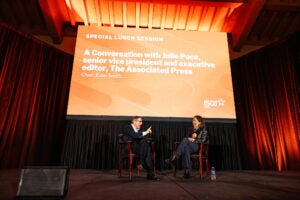March 31, 2025 | Covering the White House, ISOJ2025
‘We are standing up for the principles of the entire independent press,’ says AP executive editor Julie Pace on White House ban
Haga clic aquí para leer este artículo en español.
The Associated Press has been trying to get back in the White House press pool for almost 50 days.
Every day, its journalists are turned away, said Julie Pace, senior vice president and executive editor of the AP, during the 26th International Symposium on Online Journalism (ISOJ).

Since Feb. 11, the news agency’s journalists have been banned from participation in the White House press pool and from reporting in locations like the Oval Office and Air Force One. The catalyst was the AP’s decision not to change its stylebook entry for the “Gulf of Mexico” despite acknowledging the president’s executive order referring to it as the “Gulf of America” within the United States.
“I really would encourage everybody to think about this as something that is so much bigger,” Pace said. “It was really not just about that language that we are using. It was about whether the government can tell a news organization, or anyone, what language to use and if they don’t comply, retaliate against them.”
On Friday, March 28, Pace joined Evan Smith, co-founder of the Texas Tribune and senior advisor of the Emerson Collective, for a 20-minute conversation that touched on the controversy.
“AP is a global news organization,” Pace said. “We operate in a hundred countries around the world. And we get requests from governments all the time to use language that they prefer. And we have to make decisions around language that make sense for the broadest audiences possible.”
Following the ban, the news agency filed a lawsuit against officials of the administration of U.S. President Donald Trump to restore access to the White House, arguing that its First Amendment rights have been violated. Journalists from the AP participated in a second court session last Thursday, March 27, before U.S. District Judge Trevor N. McFadden. A decision in the case is still pending.
“The judge did not issue a ruling at the end, but we felt like it was a really substantive hearing,” Pace said. “We were able to make our arguments, and we look forward to hearing what the judge has to say.”
She reaffirmed the AP’s commitment to being part of the White House press pool for more than 100 years.
“We’ve done that through Republican administrations, Democratic administrations, and some of the most iconic reporting and images that everyone knows from presidential coverage have come from the AP,” she said.
Pace also acknowledged the AP’s good working relationship with the first Trump’s administration, Trump campaigns and the beginning of this administration.
“We are not here to be adversarial. We don’t fancy ourselves as oppositional. Because again, our entire purpose as an organization is to reach people across the political spectrum,” she said.
AP’s reporters and photographers continue to cover the White House, but being banned puts them at a disadvantage.

“We’re having to rely on reports from other news organizations. And some of those reports are very high quality, but they are a delay for us,” Pace said.
Despite the ban, she recognizes the amazing effort the AP’s White House team has been making to maintain fact-based coverage.
“AP is the representative of thousands of news organizations and four billion people around the world every day who interact with our coverage. So we’re showing up [at the White House] not for ourselves, we’re showing up for them. And we feel like that’s an important thing to do,” she said.
Pace emphasized the AP’s motives in its decision to fight against the White House ban.
“We are standing up for the principles of the entire independent press. And again, also for the public because I think this matter of speech is something that is relevant beyond the media conversation,” she said.
She also believes this is a warning for the entire press: “We may be the target now. But I don’t think we’ll be the only ones. And that’s why it’s important for us to stand up for this principle.”
Evan Smith agreed: “A fight over White House access is a fight over free speech. And a fight over free speech is a fight that everyone here has a stake in.”
At the end of the 20-minute conversation, Pace concluded: “No matter what happens, we are comfortable with the position that we have taken, and we will continue to cover this White House in the ways that we have done throughout our history, getting fact-based, non-partisan, independent [coverage].”
“Estamos defendiendo los principios de toda la prensa independiente”, dice la editora ejecutiva de AP, Julie Pace, sobre la prohibición de la Casa Blanca
Associated Press lleva casi 50 días intentando volver a entrar al grupo de prensa de la Casa Blanca.
Diariamente, sus periodistas son rechazados, declaró Julie Pace, vicepresidenta sénior y editora ejecutiva de AP, durante el 26º Simposio Internacional de Periodismo Online (ISOJ).
Desde el 11 de febrero, los periodistas de la agencia de noticias tienen prohibido participar en el grupo de prensa de la Casa Blanca y reportar en lugares como la Oficina Oval y el Air Force One. El factor desencadenante fue la decisión de AP de no cambiar la entrada en su manual de estilo sobre el “Golfo de México”, a pesar de reconocer la orden ejecutiva del presidente que lo denomina “Golfo de América” dentro de Estados Unidos.
“Animo a todos a considerar esto como algo mucho más amplio”, dijo Pace. “No se trata sólo del lenguaje que usamos. Se trata de si el gobierno puede decirle a una organización de noticias, o a cualquier persona, qué lenguaje usar y, si no cumple, tomar represalias en su contra”.
El viernes 28 de marzo, Pace se unió a Evan Smith, cofundador del Texas Tribune y asesor principal del Emerson Collective, para una conversación de 20 minutos que abordó la controversia.
“AP es una organización de noticias global”, declaró Pace. “Operamos en cien países de todo el mundo. Y recibimos constantemente solicitudes de los gobiernos para usar el lenguaje que prefieren. Y tenemos que tomar decisiones sobre el lenguaje que sean comprensibles para el público más amplio posible”.
Tras la prohibición, la agencia de noticias presentó una demanda contra funcionarios de la administración del presidente estadounidense Donald Trump para restaurar el acceso a la Casa Blanca, argumentando que se han violado sus derechos amparados por la Primera Enmienda. Periodistas de AP participaron en una segunda sesión judicial el pasado jueves 27 de marzo ante el juez federal de distrito Trevor N. McFadden. El caso aún está pendiente de decisión.
“El juez no emitió un fallo al final, pero consideramos que fue una audiencia realmente sustancial”, declaró Pace. “Pudimos presentar nuestros argumentos y esperamos con interés escuchar lo que el juez tiene que decir”.
Reafirmó el compromiso de AP de formar parte del equipo de prensa de la Casa Blanca como lo ha hecho durante más de 100 años.
“Lo hemos hecho durante administraciones republicanas y demócratas, y algunos de los reportajes e imágenes más emblemáticos que todos conocemos de la cobertura presidencial provienen de AP”, afirmó.
Pace también reconoció la buena relación de trabajo de AP con la administración del primer presidente Trump, las campañas de Trump y el inicio de esta administración.
“No estamos aquí para ser adversarios. No nos consideramos opositores. Porque, insisto, nuestro propósito como organización es llegar a personas de todo el espectro político”, dijo.
Los reporteros y fotógrafos de AP continúan cubriendo la Casa Blanca, pero la prohibición los pone en desventaja.
“Tenemos que depender de reportajes de otras organizaciones de noticias. Y algunos de esos reportajes son de muy alta calidad, pero nos suponen un retraso”, aseguró Pace.
A pesar de la prohibición, reconoce el increíble esfuerzo que el equipo de AP en la Casa Blanca ha estado realizando para mantener una cobertura basada en hechos.
“AP representa a miles de organizaciones de noticias y a cuatro mil millones de personas en todo el mundo que interactúan con nuestra cobertura a diario. Por eso, nos presentamos [en la Casa Blanca] no por nosotros mismos, sino por ellos. Y creemos que es importante hacerlo”, declaró.
Pace enfatizó los motivos de AP para su decisión de luchar contra la prohibición de la Casa Blanca.
“Estamos defendiendo los principios de toda la prensa independiente. Y, repito, también por el público, porque creo que este tema de la expresión es relevante más allá del debate mediático”, dijo.
También cree que esto es una advertencia para toda la prensa: “Puede que seamos el blanco ahora. Pero no creo que seamos los únicos. Y por eso es importante que defendamos este principio”.
Evan Smith coincidió: “Una lucha por el acceso a la Casa Blanca es una lucha por la libertad de expresión. Y una lucha por la libertad de expresión es una lucha en la que todos aquí tenemos un interés”.
Al final de la conversación de 20 minutos, Pace concluyó: “Pase lo que pase, nos sentimos cómodos con la postura que hemos adoptado y seguiremos cubriendo esta Casa Blanca como lo hemos hecho a lo largo de nuestra historia, con una cobertura basada en hechos, imparcial e independiente”.

